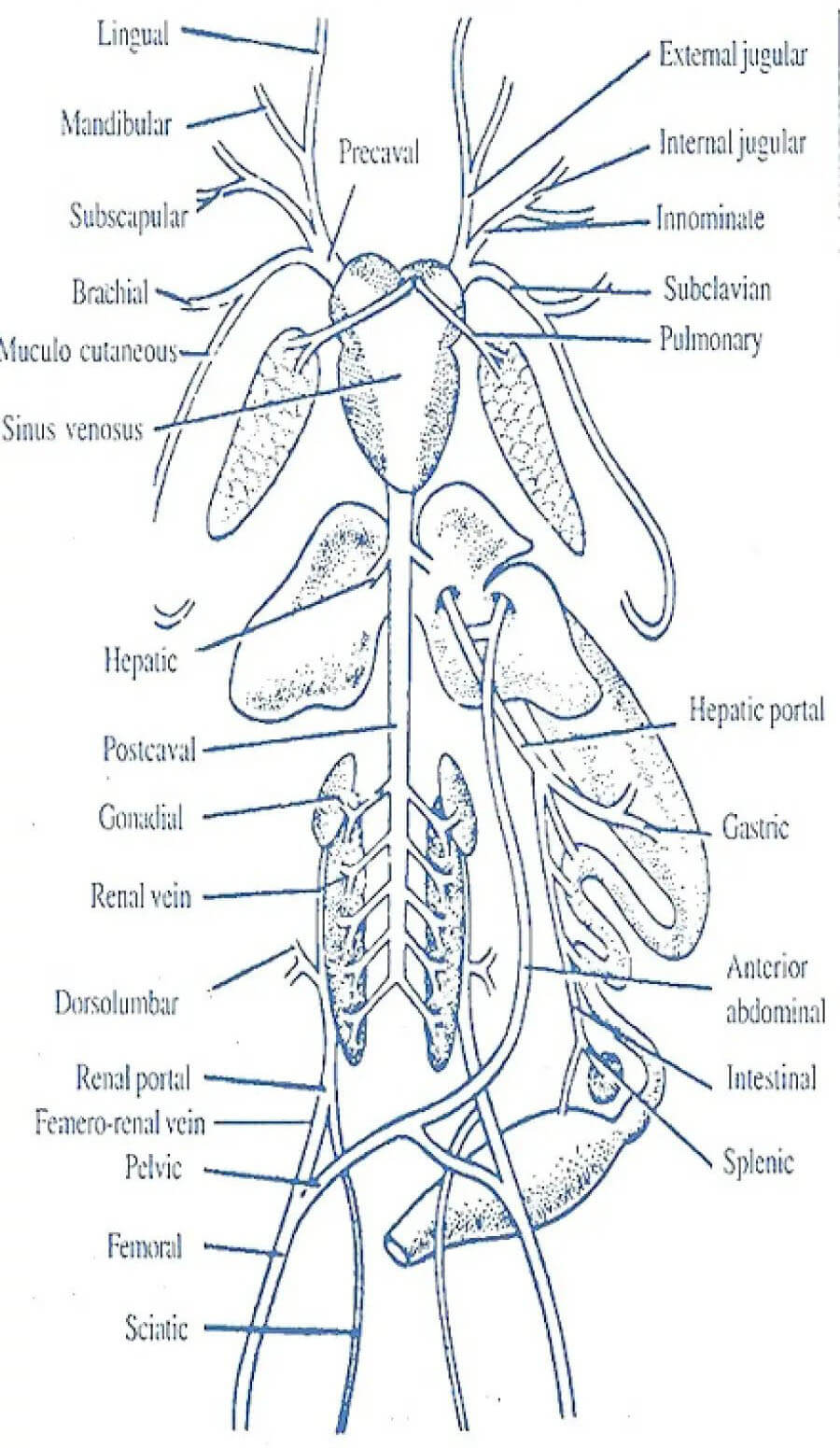Comparative Anatomy: Venous System of Frog and Rabbit
Dive into the captivating world of frog and rabbit venous systems. Discover unique adaptations and evolutionary insights.

The intricate world of anatomy never fails to amaze us with its diversity across species. A captivating realm within this subject is the comparative anatomy of venous systems, particularly when contrasting the venous systems of frogs and rabbits. These two creatures, seemingly worlds apart, share intriguing similarities and differences in how their circulatory systems function. Let's embark on a journey through their venous pathways, uncovering the unique features that characterize each one.
Understanding Comparative Anatomy
Before diving into the specifics of frog and rabbit venous systems, let's establish a solid understanding of comparative anatomy. This branch of biology delves into the study of anatomical structures across different species, aiming to identify both the shared traits and distinct variations that have evolved. By comparing these systems, scientists gain insights into the evolutionary adaptations that have shaped the diverse array of life on our planet.
Venous System of Frog: A Closer Look
Frogs, with their semi-aquatic lifestyle, have developed a venous system tailored to their needs. The venous system of a frog consists of intricate networks of veins that work in tandem to return deoxygenated blood to the heart. One remarkable feature is the presence of cutaneous veins, which lie just beneath the skin and aid in heat exchange and respiration. These veins also play a crucial role in maintaining the frog's water balance.
The Renal Portal System
A distinctive aspect of a frog's venous system is the renal portal system, a specialized network that connects the kidneys and other pelvic organs. This system serves to filter and process blood before it reaches the heart, contributing to the efficient removal of waste products.
Venous System of Rabbit: Unveiling the Complexity
Rabbits, on the other hand, exhibit a more complex venous system due to their unique physiological characteristics. As mammals, rabbits possess a four-chambered heart that supports efficient separation of oxygenated and deoxygenated blood. This intricate system is designed to sustain their high-energy lifestyle.
The Great Saphenous Vein
One prominent feature of the rabbit's venous system is the great saphenous vein, a long vessel that runs along the hind limb. This vein aids in the return of blood from the lower extremities, showcasing a parallel with human anatomy.
Portal Vein and Hepatic Portal System
The rabbit's venous system also encompasses a portal vein, which directs blood from the digestive organs to the liver. This hepatic portal system facilitates the processing of nutrients and ensures proper detoxification before the blood enters systemic circulation.
Comparing the Two: Similarities and Contrasts
When we juxtapose the venous systems of frogs and rabbits, intriguing similarities and contrasts come to light. Both creatures possess specialized venous structures that cater to their distinct needs. However, while the frog's venous system is adapted to its amphibious life, the rabbit's system aligns with its mammalian characteristics and herbivorous diet.
| Venous System of Rabbit | Venous System of Frog |
|---|---|
| Coronary veins collect the blood from the wall of the heart and open into the left precaval vein. | The coronary vein collecting blood from the wall of the heart opens into an anterior abdominal vein. |
| The blood from different organs of the body is collected by two superior vena cavae and a posterior vena cava which open separately into the right auricle. | The blood from different organs of the body is collected by two precavals and one post which unite together to form a sinus venosus that in turn opens into the right auricle. |
| Each precaval or superior vena cava is formed by three veins namely (i) External Jugular (ii) Internal jugular and iii. sub-clavian. | Each precaval vein is formed by three veins viz. (i) External jugular (ii) Innominate and (iii) subclavian. |
| The external jugular brings blood from the tongue, jaws, and muscles of the head and is connected with that of the opposite side by a jugular anastomosis. | The external jugular brings the blood from the tongue and muscles of the jaw by lingual and mandibular. |
| The internal jugular receives an internal carotid that receives blood from the brain and neck and opens into the external jugular vein. | Innominate is formed by the internal jugular bringing blood from the brain and orbit and a sub-scapular from the shoulder and back of the arm. |
| The subclavian brings blood from the shoulders and forelimbs. | The subclavian collects blood from the forelimbs by the brachial vein and from the skin and muscles of the abdomen by the Musculo-cutaneous vein. |
| Anterior intercostal veins collect blood from intercostal spaces and open into pre-cavals. | Anterior intercostal veins are absent. |
| The inferior vena cava is formed by the union of several veins. | The post-caval vein is formed by a union of four pairs of renal veins collected from the kidneys. |
| The internal iliac brings blood from the back of the thigh. The external iliac is formed by a femoral vein from the inner part of the thigh and a posterior epigastric from the ventral wall of the abdomen. The vesicular vein brings blood from the urinary bladder into the internal iliac. | The sciatic brings blood from the interior of the thigh while the femoral brings blood from the outer part of the thigh. The vesicular vein from the urinary bladder opens into the anterior abdominal vein. |
| The caudal vein collects blood from the tail. | The caudal vein is absent. |
| Ilio-lumbar from the abdomen and gonadial from gonads pour blood into the post caval vein. | A dorso lumbar from the dorsal body wall pours into the renal portal vein while the first renal vein also collects from the gonad by a gonadial vein. |
| The renal portal system is absent. | The renal portal system is well-developed. |
| The hepatic portal system is constituted by the Hepatic portal vein from different parts of the alimentary canal. | The hepatic portal system is constituted by a Hepatic portal vein from different parts of the alimentary canal and an Anterior abdominal vein from posterior parts of the body. |
| Phrenic veins bring the blood from the diaphragm into post caval vein. | Phrenic veins are absent. |


Evolutionary Significance
Examining the venous systems of frogs and rabbits not only provides insights into their unique adaptations but also highlights the evolutionary pathways they have followed. These adaptations underscore the remarkable process of natural selection, where anatomical structures shape and are shaped by an organism's environment and lifestyle.
Conclusion
In the realm of comparative anatomy, the exploration of venous systems in diverse species opens a window into the marvels of evolution. The venous system of a frog, with its emphasis on heat exchange and water balance, stands in contrast to the complex, nutrient-processing system of a rabbit. By delving into the intricacies of these systems, we gain a deeper appreciation for the diverse strategies life has developed to navigate the challenges of survival.
The information on this page is peer reviewed by a qualified editorial review board member. Learn more about us and our editorial process.
Last reviewed on .
Article history
- Latest version
Cite this page:
- Comment
- Posted by Dayyal Dungrela